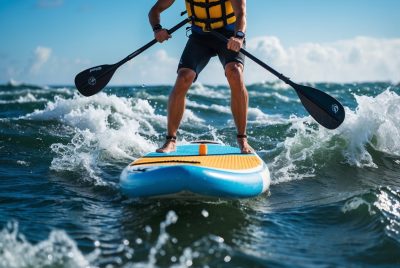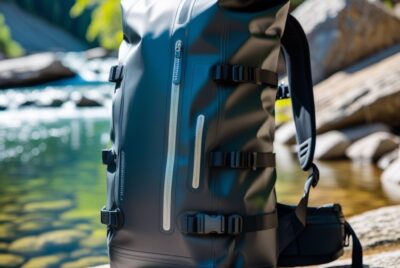Kayak Sail: Optimizing Your Paddling Adventure
*We may earn a commission for purchases made using our links. Please see our disclosure to learn more.
Kayak Sail Essentials: Optimizing Your Paddling Adventure
As someone who has experienced the thrill of catching the wind on water, I can attest to the excitement that a kayak sail offers. It’s a unique blend of kayaking and sailing that allows you to harness wind power to propel your kayak, offering both a relaxing glide and an exhilarating ride depending on the wind conditions.

I’ve observed that kayak sails come in various shapes and designs, each suited for different sailing experiences. The traditional downwind sails, for instance, are ideal for a leisurely journey with the wind at your back. More advanced designs, like the spinnaker or touring sails, cater to those looking to challenge themselves with upwind courses. Ensuring a well-informed choice can significantly enhance your time on the water.
I’ve found the installation of kayak sails to be fairly user-friendly, with most kits designed for quick setup. It’s a transformative addition to your kayaking gear, enabling greater distances with less effort. There are considerations to keep in mind, such as sail size, portability, and your kayak’s compatibility. From personal experience, selecting the right sail can extend a day’s adventure, allowing you to explore further while still enjoying the serenity of kayaking.
Kayak Sail Basics

I’ll discuss the fundamental aspects of kayak sails, including the different types that are available and the primary components that make up a sail kit. Whether you’re looking to harness the wind for a leisurely paddle or for more efficient travel, understanding these basics is essential.
Types of Kayak Sails
There are several types of kayak sails based on design and function:
- Downwind Sail: Specifically designed for sailing with the wind directly behind me. These are often simple to deploy and do not require complicated rigging.
- V-Shaped Sail: This design captures wind from a wider angle, offering more versatility in wind conditions.
- Spirit Sail: Attached to a forward mast and a boom, providing stability and the ability to sail in various wind directions, though it requires more skill to manage.
The material typically used for these sails includes lightweight nylon or polyester, which offers durability and ease of handling. Laminated cloth can also be found in higher-end models for increased performance.
Key Components
The kayak sail kit comes with several components necessary for operation:
- Mast: Usually made of materials like aluminum, carbon fiber, or PVC pipes, the mast supports the sail.
- Sail: The cloth part, often made from lightweight materials like polyester or nylon.
- Rigging: Includes all the ropes, lines, and hardware to attach and control the sail.
Each component should be properly maintained to ensure the longevity and effectiveness of the kayak sail. It’s important to choose quality materials, such as corrosion-resistant plastic fittings, to withstand the marine environment.
Selecting a Kayak Sail

When I choose the best kayak sail for my kayak, I consider materials for durability and the sail design for efficiency. I also ensure that the sail is compatible with my kayak and that I can install it easily.
Materials and Durability of a Kayak Sail
In selecting a kayak sail, I look for durable materials that can withstand frequent use and various wind conditions. I prefer sails made of high-quality polyester or nylon because these materials resist UV damage and tears. A sail with a clear window is also essential for visibility. For durability, I check customer reviews to see how sails hold up over time.
Sail Design and Efficiency
The design of the sail significantly affects performance. I consider L-shaped sails for their ease of use and ability to catch side and following winds, while V-shaped sails can be more efficient when sailing upwind. For downwind sailing, a spinnaker design can provide a significant speed boost. The efficiency of my sail also involves its shape and how well it channels the wind, which in turn, affects how much it enhances my paddling efforts.
Compatibility and Installation
My sail must be compatible with my kayak – whether it’s sit-on-top or sit-in, and whether or not it has a rudder or skeg. I pay attention to the mounting method; many kayak sails come with straps or clips making them easy to install. I prefer sails with installation kits that do not require any drilling into my kayak. Moreover, I opt for sails in a color that suits my style while providing good visibility for safety.
Kayak Sailing Techniques and Tips

In this section, I’ll guide you through mastering the art of kayak sailing. From using the wind to your advantage to maintaining safety and enhancing performance, these techniques and tips will bolster both your kayaking and sailing experience.
Harnessing the Wind
To effectively harness the wind, you must understand the ‘points of sail’. These are the angles at which you can sail in relation to the wind direction. In a sea kayak, aligning the sail at different angles allows you to capture the wind optimally:
- Close Reach: This is about 45-60 degrees off from where the wind is coming. It’s a powerful point of sail where I find a balance between speed and control.
- Beam Reach: Here, the wind hits the side of the kayak. I’ve noticed this is often the fastest point of sail.
- Downwind: With a downwind spinnaker, I can maximize my speed when heading straight downwind, as the sail catches the wind like a large parachute.
Knowing how to adjust my kayak sail depending on these points ensures efficient use of the wind for propulsion.
Safety and Control
To maintain safety and control while kayak sailing, I practice these fundamental techniques:
- Edging: By shifting my weight to the edge of the kayak, I can stabilize the vessel against tilting caused by the wind.
- Bracing: Should a gust tip me to the side, a quick bracing stroke on the water’s surface regains my balance.
- Technique Adjustments: It’s crucial to adapt my paddling technique when the sail is up. Shorter, more frequent strokes help me control direction without overexerting myself.
Consistent practice in different conditions develops my ability to react and maintain control, reducing the likelihood of a tip-over incident.
Performance Optimization
For maximum performance, I consider these factors:
- Sail Tuning: Adjusting sail tension and angle relative to the wind fine-tunes my speed and efficiency.
- Body Positioning: I ensure my weight is distributed evenly, and I sit as low as possible in the kayak to lower the center of gravity, which enhances balance and stability.
- Exertion: Balancing the use of the sail and my paddling effort allows me to travel faster while conserving energy.
By focusing on these aspects, I optimize my kayak sailing adventure with an incremental, yet a substantial boost in efficiency and speed.
Accessories and Gear for Kayak Sailing

When outfitting a kayak for sailing, choosing the right accessories and gear ensures a smooth and efficient experience on the water. Critical considerations include the integration of sailing kits and additional equipment for functionality, as well as regular maintenance and proper storage techniques for longevity.
Additional Equipment
For a cohesive setup, a kayak sail kit generally includes sails made of sturdy materials like Dacron fabric, which is essential for durability and performance. Brands such as Hobie have developed robust sail kits designed for seamless use with their kayaks, delivering hands-free operation and enhancing the sailing experience, especially for kayak fishing enthusiasts. I recommend considering kits like the WindPaddle Adventure Sail for downwind sailing or the Sea Eagle QuikSail for its compact design and ease of deployment.
In addition to the sail itself, additional equipment can include:
- Leeboards: Necessary for improved tracking and windward performance.
- Bungees and leashes: To secure the sail when not in use and avoid losing gear overboard.
- Aluminum frames: Found in some sail kits for added stability and shape retention.
Opting for a lightweight sail like the WindPaddle Scout Sail, which typically weighs less than comparable models, provides advantages in terms of ease of handling, particularly for the experienced kayaker. For those interested in kayak fishing, a sail that allows for pedaling while deployed, such as the Hobie Mirage Sail Kit, can be a game-changer.
Maintenance and Storage of Your Kayak Sail
To preserve the functionality and appearance of kayak sails, regular maintenance is essential. I advise cleaning the sail with fresh water after each use, especially when sailing in saltwater conditions, to prevent corrosion and material degradation. Here’s a table to summarize the care routine:
| Task | Frequency | Notes |
| Rinsing | After each use | Remove salt, dirt, and debris. |
| Drying | Before storage | Prevent mold and mildew. |
| Inspection | Seasonally | Check for wear and tear in sails and rigging. |
| Repair | As needed | Address tears, loose seams, or hardware issues. |
For storage, it’s paramount to ensure sails are completely dry before storing them in a cool, dry place away from direct sunlight. Fold or roll sails loosely to avoid permanent creasing and use a protective bag to shield them from dust and pests. By following these maintenance guidelines, you can extend the life of the kayak sail and ensure it’s ready for your next adventure.
Frequently Asked Questions
In my exploration of kayak sailing, I’ve gathered a trove of insights to address common curiosities and concerns, fine-tuning the details to help you make informed decisions for your sail-powered ventures.
1. What are the top-rated kayak sails available on the market?
My research indicates the popularity of certain models due to their ease of use, durability, and performance. Brands like Vortex, WindPaddle, and Advanced Elements consistently receive high marks for their kayak sails.
2. How do you properly install a sail kit on a kayak?
Installation requires following manufacturer instructions meticulously to ensure safety and performance. Generally, you’ll affix the mast at a secure point, connect the sail, and rig any necessary lines without impeding your movement or the kayak’s stability.
3. What are the essential considerations when choosing a mast for a kayak sail?
The mast’s material, strength, and compatibility with both your kayak and sail are paramount. A robust yet lightweight mast guarantees optimal control and maneuverability while reducing unnecessary drag.
4. How does adding a sail improve the kayaking experience?
Introducing a sail to kayaking allows for longer expeditions with less fatigue by harnessing wind power. Additionally, it offers a refreshing learning curve and heightened excitement on the water.
5. Is it possible to use a kayak sail on different types of watercraft, such as a paddle board?
Yes, with proper mounting systems, kayak sails can be adapted for use on different vessels, including paddle boards, considering they are designed for versatility and as long as the sail’s specifications align with the watercraft’s design and capabilities.




